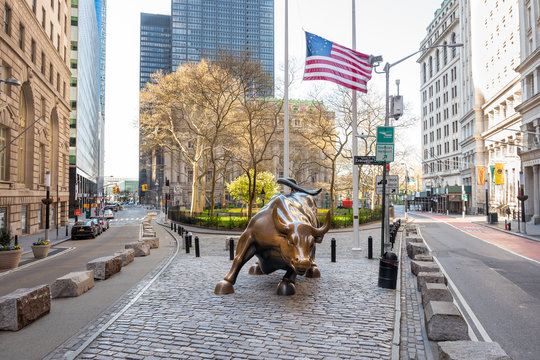Business
Why Does Wall Street Have Jitters Moving Forward In 2025 Despite A Mega 2024? What Can Be Said For Indian Stock Markets?
Wall Street going forward in 2025 is asking one question – can the momentum sustain, or is the clock ticking on this euphoric rally?
Published
9 months agoon

As the curtain rises on 2025, optimism from a stellar 2024 in global markets is tempered by a mix of hope and apprehension. The past year delivered meteoric gains on Wall Street, propelling consumer confidence and lavish spending, thanks to the spectacular performance of tech-heavy indices and surging stock portfolios.
Yet, the lingering question that many are now asking – can the momentum sustain, or is the clock ticking on this euphoric rally?
The Glorious 2024 At Wall Street. A Look Back
Wall Street celebrated an extraordinary 2024, marked by a resounding 29% surge in the Nasdaq, riding high on the artificial intelligence boom and the dominance of the so-called “Magnificent Seven” tech stocks.
This followed an even more jaw-dropping 43% leap in 2023. Meanwhile, the S&P 500 added an eye-popping $10 trillion in value, underscoring the market’s sheer power in fueling economic growth.
These staggering numbers translated into tangible effects – consumers, buoyed by their growing portfolios, spent with newfound confidence, creating a virtuous cycle of growth. The wealth effect—a phenomenon where rising asset values spur spending—was in full swing, driving the economy’s robust performance.
Cracks in the Foundation With Overvaluation Concerns
However, not all is rosy as we enter 2025. Economists and market analysts are raising alarms about unsustainably high valuations.
Mark Zandi, chief economist at Moody’s Analytics, described the market as “very richly valued, bordering on frothy.” Drawing parallels to the late 1990s dot-com bubble, Zandi warns of a potential market correction, which could exceed 20%.
Unlike the catastrophic dot-com bust, Zandi does not foresee an outright collapse. However, he cautions that even a moderate market downturn could severely dent the economy. A sharp decline in portfolio values would undermine fragile consumer confidence, leading to reduced spending—a critical blow in an economy where consumer activity remains the primary growth engine.
The Indian Parallel. Similar Fears in a Different Market
Interestingly, Wall Street’s jitters echo concerns that have been simmering in Indian stock markets. Despite a remarkable recovery post-pandemic, there are growing fears that certain stocks are now priced far beyond their intrinsic value. This disconnect between price and fundamentals has raised the specter of a painful correction that could ripple through India’s economy.
Indian markets, much like their American counterparts, have been buoyed by technology and growth-focused sectors. However, the lack of structural reforms and rising interest rates are creating headwinds, prompting investors to tread cautiously.

Are Markets Detached from Reality?
As 2025 begins, the US economy looks promising. Layoffs remain low, inflation has cooled, wages are outpacing price increases, and gas prices are stable. Yet, this optimistic backdrop has not quelled concerns about one critical issue – overvaluations in financial markets.
David Kelly, chief global strategist at JPMorgan Asset Management, warns of the “danger” posed by high valuations, which leave markets vulnerable to sudden corrections. He pointed out about asset bubbles, built on foundations of a very stable economy spotlight particularly frothy valuations in large-cap US stocks and speculative assets like bitcoin – a big correction at some stage in the things that are not tethered to reality could take a shellacking; therefore investors must think carefully about how much risk they are taking.
According to Morningstar, the US stock market is currently trading at a roughly 5% premium to its intrinsic value, down slightly from 6.9% before December’s selloff. Earlier in 2024, stocks were trading at a discount, making the current scenario less forgiving.
Seth Meyer, global head of client portfolio management at Janus Henderson Investors explains that tighter valuations leave less room for recovery when markets face turbulence, making stocks more susceptible to pullbacks.
Matt Rowe, head of portfolio management and cross-asset strategies at Nomura Capital Management notes that in the new year what needs to be watched out for is that we are priced for perfection and any deviation from perfection is going to result in some pretty heavy negative marks.
Predicting Market Corrections
Timing the stock market remains notoriously difficult. Overvalued stocks can continue to inflate for extended periods, as history demonstrates. During the late 1990s dot-com boom, some internet companies with no revenue continued to gain value until the bubble burst in 2000.
Even in the face of the worst inflation crisis in four decades and the Federal Reserve’s aggressive rate hikes reminiscent of Paul Volcker’s era, the current bull market has proven resilient but betting against this momentum has been costly, illustrating the unpredictable nature of market dynamics.
Inflation Risks. A Lingering Concern for Markets in 2025
While market valuations dominate the conversation, inflation remains a pressing concern for many experts.
Marci McGregor, head of portfolio strategy and chief investment officer at Merrill and Bank of America Private Bank, spoke about the cyclical nature of inflation stating inflationary cycles throughout history, like the one after the COVID-19 pandemic, tend to have multiple peaks with long lags between them. This means inflation could reaccelerate in the coming months or years, posing a significant risk.
Recent inflation data suggests stalled progress in bringing price pressures back to the Federal Reserve’s target level. Such a scenario could prematurely end the Fed’s interest-rate cuts or even lead to rate hikes—developments that could rattle markets.
Although McGregor does not view this as her base case, the possibility is enough to warrant caution. Jim Caron, chief investment officer of the portfolio solutions group at Morgan Stanley Investment Management, agrees, noting that sticky inflation “really starts to change the narrative in the market.” While not a primary expectation, it remains a risk worth monitoring.
Supply-Side Dynamics
The progress on disinflation in recent years has been driven largely by supply-side strength, says Josh Hirt, senior US economist at Vanguard. Higher productivity in the labor market and a boost in immigration have stabilized labor supply, enabling economic growth while moderating price pressures.
Geopolitical events also pose risks to supply stability. Steven Wieting, chief economist and chief investment strategist at Citi Wealth, raises concerns about potential supply shocks from tariffs or conflicts, such as those in the Middle East or Ukraine.
:max_bytes(150000):strip_icc()/GettyImages-1244209294-83f247421f4c41df81c7471c66ef8217.jpg)
UBS Issues a Bubble Warning – Are Markets Heading for Trouble?
Cracks are beginning to show in the market as investors scrutinize the heavy reliance on the “Magnificent Seven”—Alphabet, Amazon, Apple, Meta, Microsoft, Nvidia, and Tesla. These tech giants have disproportionately driven market gains, creating a potential vulnerability.
To put this into perspective, the S&P 500 delivered an impressive two-year total return of 58% (including dividends). However, without the contribution of the Magnificent Seven, that return would have plummeted to just 24%, according to S&P Dow Jones Indices.
As US stocks ended 2024 on a weak note, the volatility spilled into the first trading day of 2025. UBS sounded the alarm, warning that nearly all seven preconditions for a market bubble are already in place.
Andrew Garthwaite, UBS global equity strategist, outlined the risks in a December 18 report, stating that when a bubble bursts, investors often lose as much as 80% of their investments. He pointed to historical precedents like the Nifty 50 bubble of the 1970s, Japan’s asset bubble in the late 1980s, and the dot-com bubble of the early 2000s.
UBS identified several bubble preconditions that currently exist, including –
—A significant gap of at least 25 years since the last bubble.
—Heavy retail investor participation.
—Corporate profits under pressure.
Garthwaite noted that bubbles are often fueled by narratives like “this time is different,” typically tied to technological advancements or market dominance. “We have both,” he warned.
However, there is some good news. UBS argues that the market hasn’t fully entered bubble territory. In fact, stocks could potentially rally another 15% to 20% before the bubble threshold is clearly breached. However, the fact that major Wall Street banks are openly discussing the possibility of a bubble is indicative of the growing concerns.
Even if the market isn’t in a bubble, numerous factors could trigger a downturn, especially given the sky-high expectations. One risk is that one or more of the Magnificent Seven could falter, dragging down the rest of the group and the broader market. With expectations for these stocks set impossibly high, any stumble could have outsized repercussions.
External Catalysts. Debt Ceiling and Policy Uncertainty
Adding to market jitters, lawmakers in Washington must struggle with the reinstated debt ceiling, a fiscal time bomb that could destabilize the economy if not resolved.
Investors are also parsing through the incoming Trump administration’s economic policies, which include tax cuts, tariff hikes, deregulation, and mass deportations. These measures could have wide-ranging implications, from boosting corporate profits to sparking trade tensions and labor shortages.
Investors are thus concerned with the uncertainty surrounding the incoming Trump administration’s economic agenda, which includes promises of tax cuts, tariff hikes, deregulation, and mass deportations. Each of these proposals carries the potential to either buoy or destabilize markets, depending on how they are implemented.
President-elect Donald Trump’s campaign centered on sweeping economic changes, but translating those promises into actionable policies remains a question mark. “How [Trump’s] policies are executed will be very important for near-term growth,” says Seth Meyer, global head of client portfolio management at Janus Henderson Investors.
While Meyer believes the long-term economic outlook won’t shift dramatically, he emphasizes that the way tariffs or other policy changes are rolled out could significantly influence growth in 2025—and, by extension, market valuations.
Trouble Brewing in the Bond Market
While equity investors weigh the risks and rewards of Trump’s agenda, signs of strain may first appear in the bond market.
Ed Yardeni, president of Yardeni Research and the economist who coined the term “bond market vigilantes” in the 1980s, warns that a bond market selloff could spook equities if the 10-year Treasury yield nears 5%. Such a scenario would raise borrowing costs and dampen market enthusiasm. Yardeni also notes the federal budget deficit as a looming concern.
What Could Happen Instead
After a remarkable rally, it’s natural for some investors to brace for a potential market reversal. However, a downturn isn’t the only scenario on the table.
Markets might not crash but could instead move sideways, allowing corporate earnings to align with lofty valuations. This period of consolidation could provide a breather for overextended stocks.
Ed Yardeni, president of Yardeni Research, doesn’t foresee a high risk of a bear market—a drop of 20% or more—given the absence of recessionary indicators. However, he anticipates a 10% to 15% correction, which he describes as a “buying opportunity, not a reason to panic,” even though it could be uncomfortable for investors.
Kristina Hooper, chief global market strategist at Invesco, shares a similar outlook. She suggests that long-term investors should focus on the broader picture, as the environment remains favorable for equities and risk assets.

Could the Indian Stock Market Follow Suit?
India’s equity market has been on an upward trajectory, fueled by strong domestic growth, structural reforms, and an increasingly skilled workforce. Despite global economic volatility, India’s resilience has been evident, with the market outperforming many global indices in 2024.
This momentum has been driven by strong domestic consumption, investor confidence, and promising growth prospects. India is now positioned as a critical player in emerging markets, with projections for real GDP growth of 6.5% to 7% in 2025.
Citi’s recent analysis notes India’s potential to remain the fastest-growing major economy in 2025, projecting 7% GDP growth driven by industrial expansion and consumer demand. However, with market valuations currently at 22 times projected earnings for 2025, there is limited room for disappointment in earnings growth. Comparatively high valuations against the MSCI Emerging Markets Index also raise concerns about a potential correction.
A Note of Caution
Dhiraj Relli, MD & CEO of HDFC Securities, recently cautioned about India’s markets, citing weak corporate earnings momentum, a seven-quarter low in economic growth, and persistent inflation. Relli also noted that foreign portfolio investor (FPI) appetite remains fickle, swayed by global events and sentiment.
He suggested that while a strong start to 2025 is likely, driven by Trump’s inauguration and India’s Union Budget, challenges could arise later. Inflation, driven by supply-side issues, and a delayed global growth revival may dampen returns. He forecasts an initial 10% upside in 2025 but tempers expectations for year-end gains unless geopolitical tensions ease and Trump adopts a pragmatic approach to policy.
Risks to Watch
Several key risk factors could derail the ongoing bull run –
—Global and Domestic Growth Slowdowns: Persistent weakness in growth could weigh heavily on markets.
—Inflationary Pressures: Both global and local inflation remain stubborn, particularly due to supply-side constraints.
—Geopolitical Tensions: The Sino-US dynamic, along with broader geopolitical uncertainties, could disrupt market momentum.
—Policy Uncertainty: Trump’s policies—ranging from tariffs and tax cuts to immigration restrictions and environmental deregulation—carry significant implications for global markets.
—Climate Change and Supply Disruptions: Weather-related challenges impacting agricultural production could exacerbate inflation and growth concerns.
While every dip in the current market has been met with buying, the road ahead requires vigilance. Investors should temper their expectations and stay attuned to macroeconomic and geopolitical developments, ensuring a balanced approach to portfolio management in 2025.
The Last Bit
As 2025 unfolds, the global markets are at a crossroads. While the tailwinds of innovation, technological advancements, and economic recovery are undeniable, the risks posed by overvaluation, geopolitical uncertainties, and potential corrections loom large.
For Wall Street, a reality check seems inevitable as markets align with fundamentals. For Indian markets, the challenge lies in managing structural bottlenecks while capitalizing on long-term growth opportunities.
For investors the new year holds promise, but it also demands caution—a reminder that in the world of markets, what goes up must eventually reconcile with reality.
You may like
-


Taiwan’s ‘Historic’ TSMC Deal, A Win Or The End Of Its ‘Silicon Shield’ As China Threatens? A Jittery Taiwan Watches Trump’s Moves On Ukraine, Wondering, Could We Be Next?
-


Indian Stock Market In Turmoil. Investors In Panic Mode, Is This A Temporary Correction Or The Start Of A Bear Market?
-


America And China’s Thirst For Gold In 2025 Is Draining Other Countries’ Reserves; Here’s Why?
-


Indian Stock Markets In Meltdown Mode—Is It Time To Buy The Dip? Gold Is On Fire, And There’s No Stopping It!
-


With The Markets Cracking, Should The Incoming Batch Of IPOs Worry?
-


Germany’s Friedrich Merz’s Big Balancing Act—Trump, Borders & Europe’s Future. Can He Deliver?
